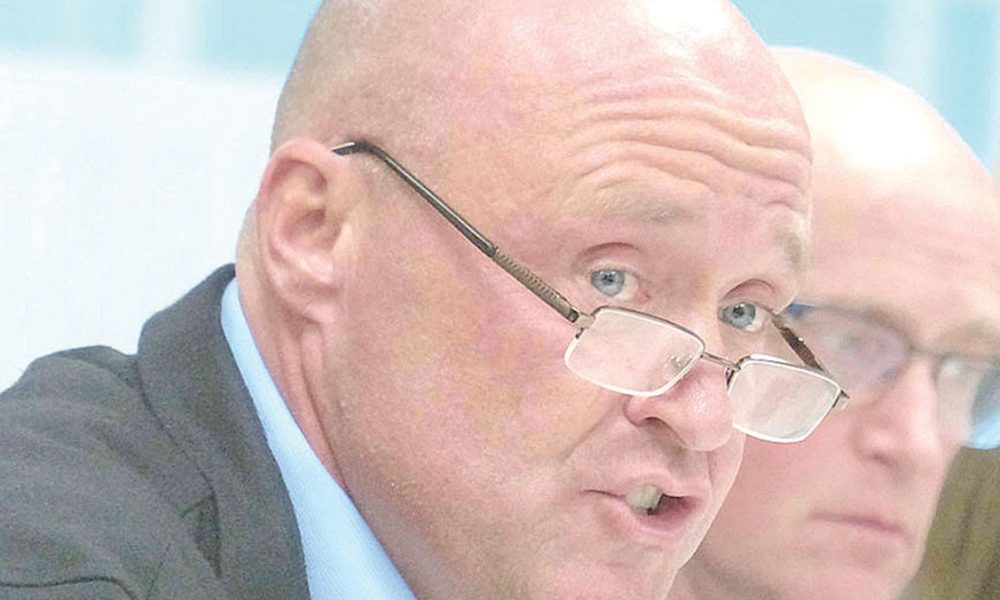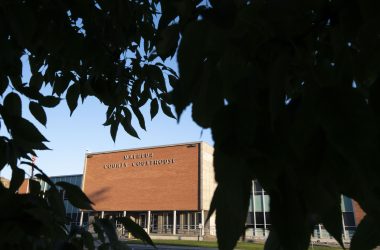
Greg Smith, Malheur County economic development director, is managing development of the Treasure Valley Reload Center. (The Enterprise/file)
NYSSA – Malheur County economic development officials are correcting million-dollar errors contained in a report to the state on the proposed Treasure Valley Reload Center, the rail shipping center planned for Nyssa.
A crucial chart in last September’s submission to the Oregon Department of Transportation overstated the cost of rail construction, misrepresented land costs, and understated road improvements by nearly $3 million.
The figures were an effort by the Malheur Economic Development Corp. to account to the state for how it would use $26 million in public money for the Nyssa project. The September submission followed months of work, including that by consultants who were paid $343,856.
Greg Smith, Malheur County economic development director who is managing the project, said Monday that “human error” caused an inaccurate chart to be submitted to state officials.
“That chart should never have been included,” Smith said.
Smith said the errors were discovered after the Malheur Enterprise raised questions about land costs in recent days. On Monday afternoon, Smith wrote to the Malheur County Court acknowledging the errors. He said the newspaper “correctly identified” inconsistencies in the report.
“I thanked them for bringing this to my attention,” he wrote.
DOCUMENT: Greg Smith’s letter to Malheur County Court.
But Smith’s efforts to explain away the discrepancies only added to confusion that first emerged with a consultant’s report a month ago. The Tioga Group, evaluating the Malheur County project for the state, said in its Jan. 7 report that land costs were listed at $1.6 million in one place and $2.8 million in another.

Smith has offered several explanations.
On Jan. 12, he said in an interview when asked about the discrepancy that “I’d have to go look” to explain the numbers.
On Jan. 21, in an email to the Enterprise he wrote that “there is a very logical reason” for the discrepancy but didn’t elaborate.
A week later, he wrote in an email to the Enterprise, “When the real estate transactions are complete, we can explain the discrepancy.”
Buying land in Nyssa is a crucial step to erecting the rail shipping center that would serve the region’s onion industry with faster service to markets.
DOCUMENT: Treasure Valley Reload Center proposal.
Smith’s team and the volunteer board of the Malheur Economic Development Corp. last year picked three parcels in Nyssa to consider. That board includes Grant Kitamura, CEO of Baker and Murakami Produce; Lynn Findley, state representative from Vale; Toni Parish, a vice president of Northwest Farm Credit Services; Kay Riley, president of Snake River Produce; Corey Maag, owner of Jamieson Produce; Jeremy Leathers, general manager of Americold Logistics; John Qualls, senior vice president of Bank of Eastern Oregon; and Jim Farmer, president of Fort Boise Produce.
The public corporation told the state, though, in its Sept. 27 bid to get the state money that the rail project would use only one property, a parcel owned by the family of Jim Farmer, who sits on the board. He has recused himself from decisions affecting his family’s land.
In two places, the submission to the state listed “land acquisition” costs at $1.6 million.
DOCUMENT: Treasure Valley Reload Center capital costs chart.
In another section of the proposal, the corporation said the cost of the Farmer land was $2.8 million.
But neither number was correct, the Enterprise has established.
According to a sales agreement executed last July 18 and two months before the submission was made to the state, Malheur County agreed to pay the Farmer family $3 million for the parcel.
On Monday, Smith couldn’t explain why the state wasn’t told actual price of the land.
The state also wasn’t told about another land deal – that the county has agreed to buy property from Nyssa Industries Inc. for $394,000. Smith said Monday that would be paid for with the state’s money. He also said the development corporation was still considering buying yet a third piece of property in Nyssa, adding another $500,000 that he said would be paid by the state. County officials said, however, that there is no signed deal yet for what is referred to as the Bybee property.
According to the submission to the state, the three parcels together could cost $3.913 million – more than double the land costs identified to the state.
Smith last week conducted a public call-in to update the community about the project following the Enterprise’s report about concerns raised by consultants. In that call, Smith said the project would use three parcels.
“That is about $2.8 million,” he said, understating the total land costs by about $1 million.
Smith blamed the confusion on the use of a single chart – “Figure 22” in the proposal to the state. That chart listed the land costs of $1.6 million – and provided other details about how the development corporation would spend the state’s $26 million.
On Monday, Smith said the figures in that chart were old. In his letter to county commissioners, he wrote that the chart was “created prior to the real estate negotiations and I didn’t catch the error.”
That conflicts with available records. The real estate deals for the two properties were finished in early July. The submission to the state includes a document listing costs as of Sept. 13 – two weeks before the report was dispatched to the state.
That Sept. 13 document said that the figures including the land costs were “current preliminary estimates” prepared after “considerable initial analysis.”
Smith said that the real costs for the Nyssa project were more accurately listed in another chart sent to the state. That chart, however, contains no cost for land. Instead, according to the report, that particular chart was intended to show “the economic contribution of construction” to the Malheur County economy. The report said that the “costs for railroad track were excluded” from that chart.
ECONorthwest, a Portland consulting firm retained for the project, wouldn’t answer specific questions, instead providing a short statement.
“We conducted an economic and financial feasibility analysis that estimated the potential demand, utilization, economic impacts, and public benefits from operations of the facility,” wrote Allison Tivnon, the firm’s marketing director. “The cost of land acquisition, construction, and engineering were estimated by other members of our team and provided to ECONorthwest.”
In the report, there are differences between the Sept. 13 cost estimates and the listed construction costs.
Smith said the numbers in the construction estimates were more accurate.
In the Sept. 13 estimate, the state was told rail improvements would use $10 million in state money. Later in the report the construction estimate dropped the figure to $3 million.
In the Sept. 13 estimate, the state also was told road improvements would cost $308,000.
The construction estimate boosted that to $3.080 million.
The shifting estimates are likely to prompt more questions in Salem. The Tioga Group, the state’s consultants, questioned Union Pacific Railroad’s commitment to the Nyssa project. A special state review committee endorsed the project, but urged the state to press for more proof that the railroad would be part of the project.
DOCUMENT: State consultant’s report.
One consultant, RailPros Field Services, last October billed the project $25,000 to represent the development corporation in “final negotiations with Union Pacific Railroad.”
A company official didn’t respond to written questions about what the company had done for that fee.
In his call last week, Smith addressed concerns about the railroad, saying Union Pacific was preparing yet another letter showing its support for the Nyssa project. Railroad officials didn’t respond to an email seeking comment.
The Oregon Transportation Commission is scheduled to review the Nyssa project on Feb. 21. Smith is scheduled to appear, and he said Monday he was preparing a presentation to correct information from the original proposal.
Les Zaitz: [email protected] or 541-473-3377.




